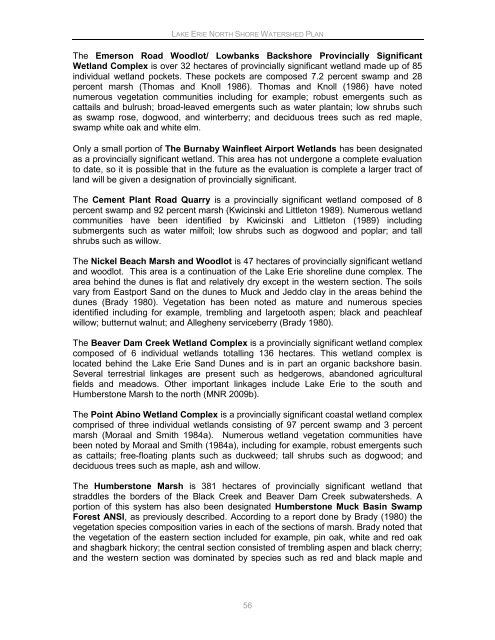Lake Erie North Shore Watershed Plan - Niagara Peninsula ...
Lake Erie North Shore Watershed Plan - Niagara Peninsula ...
Lake Erie North Shore Watershed Plan - Niagara Peninsula ...
You also want an ePaper? Increase the reach of your titles
YUMPU automatically turns print PDFs into web optimized ePapers that Google loves.
LAKE ERIE NORTH SHORE WATERSHED PLAN<br />
The Emerson Road Woodlot/ Lowbanks Backshore Provincially Significant<br />
Wetland Complex is over 32 hectares of provincially significant wetland made up of 85<br />
individual wetland pockets. These pockets are composed 7.2 percent swamp and 28<br />
percent marsh (Thomas and Knoll 1986). Thomas and Knoll (1986) have noted<br />
numerous vegetation communities including for example; robust emergents such as<br />
cattails and bulrush; broad-leaved emergents such as water plantain; low shrubs such<br />
as swamp rose, dogwood, and winterberry; and deciduous trees such as red maple,<br />
swamp white oak and white elm.<br />
Only a small portion of The Burnaby Wainfleet Airport Wetlands has been designated<br />
as a provincially significant wetland. This area has not undergone a complete evaluation<br />
to date, so it is possible that in the future as the evaluation is complete a larger tract of<br />
land will be given a designation of provincially significant.<br />
The Cement <strong>Plan</strong>t Road Quarry is a provincially significant wetland composed of 8<br />
percent swamp and 92 percent marsh (Kwicinski and Littleton 1989). Numerous wetland<br />
communities have been identified by Kwicinski and Littleton (1989) including<br />
submergents such as water milfoil; low shrubs such as dogwood and poplar; and tall<br />
shrubs such as willow.<br />
The Nickel Beach Marsh and Woodlot is 47 hectares of provincially significant wetland<br />
and woodlot. This area is a continuation of the <strong>Lake</strong> <strong>Erie</strong> shoreline dune complex. The<br />
area behind the dunes is flat and relatively dry except in the western section. The soils<br />
vary from Eastport Sand on the dunes to Muck and Jeddo clay in the areas behind the<br />
dunes (Brady 1980). Vegetation has been noted as mature and numerous species<br />
identified including for example, trembling and largetooth aspen; black and peachleaf<br />
willow; butternut walnut; and Allegheny serviceberry (Brady 1980).<br />
The Beaver Dam Creek Wetland Complex is a provincially significant wetland complex<br />
composed of 6 individual wetlands totalling 136 hectares. This wetland complex is<br />
located behind the <strong>Lake</strong> <strong>Erie</strong> Sand Dunes and is in part an organic backshore basin.<br />
Several terrestrial linkages are present such as hedgerows, abandoned agricultural<br />
fields and meadows. Other important linkages include <strong>Lake</strong> <strong>Erie</strong> to the south and<br />
Humberstone Marsh to the north (MNR 2009b).<br />
The Point Abino Wetland Complex is a provincially significant coastal wetland complex<br />
comprised of three individual wetlands consisting of 97 percent swamp and 3 percent<br />
marsh (Moraal and Smith 1984a). Numerous wetland vegetation communities have<br />
been noted by Moraal and Smith (1984a), including for example, robust emergents such<br />
as cattails; free-floating plants such as duckweed; tall shrubs such as dogwood; and<br />
deciduous trees such as maple, ash and willow.<br />
The Humberstone Marsh is 381 hectares of provincially significant wetland that<br />
straddles the borders of the Black Creek and Beaver Dam Creek subwatersheds. A<br />
portion of this system has also been designated Humberstone Muck Basin Swamp<br />
Forest ANSI, as previously described. According to a report done by Brady (1980) the<br />
vegetation species composition varies in each of the sections of marsh. Brady noted that<br />
the vegetation of the eastern section included for example, pin oak, white and red oak<br />
and shagbark hickory; the central section consisted of trembling aspen and black cherry;<br />
and the western section was dominated by species such as red and black maple and<br />
56
















